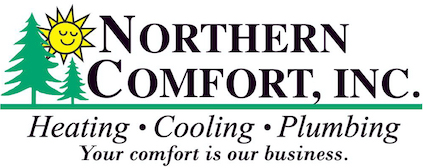
Every floor in your home should be a retreat that’s warm and comfy in the cold months and cool and comfortable in the summer. However, owners of some multi-level residences find the upper floor is stubbornly hotter or colder than the rooms on ground level.
This could merely be caused by the fact that most thermostats in a house are on the ground floor, which is where people spend the the majority of time—in the living room, kitchen, etc.—so it makes sense to set the temperature according to how it feels on the first floor.
However, temperature differences between the upstairs and downstairs could also be due to problems with your HVAC system. Some of these issues can be resolved relatively quickly while others might require more extensive and costly fixes. Here, the specialists at Northern Comfort Inc will help you figure out why the upstairs of your home is hotter than downstairs, or vice versa.
Why Is It Hotter Upstairs?
The phenomenon of the upstairs of a two-story home feeling hotter than the downstairs can be attributed to several factors. First, heat rises, so it’s common for the second floor of a home to get hotter than the ground floor. Poor insulation in the attic or roof can make this worse by allowing heat transfer from the roof into the upstairs rooms.
Another common reason is that the air conditioner is not strong enough to cool the entire home, causing it to have difficulty cooling the upstairs adequately.
To tackle these issues, homeowners could add additional insulation in the attic and make sure their home has sufficient ventilation. If there’s concern the air conditioner is the proper size for the home, call an experienced HVAC company like Northern Comfort Inc inspect the unit. A skilled professional also can help find a unit that's better suited for your home if you require air conditioning installation or replacement.
Why Is My Upstairs Always Cold/Not Heating?
When the downstairs of your home is warm, but it’s freezing upstairs, that could result in a very chilly night for anyone whose bedrooms are on the upper floor. The most frequent explanations for an upstairs not heating like it is supposed to are the insulation levels and the ductwork.
Inadequate insulation permits cold air to seep through the home’s attic or walls and contribute to heat loss, resulting in colder temperatures on the upper levels. It’s crucial to make sure your home has a thick, level layer of insulation in the attic and proper insulation in the walls to keep the cold out and the heat inside.
The ductwork in a home plays a critical role in circulating conditioned air throughout different locations of the building. However, issues with the ductwork can cause the upstairs being colder than the lower floor. A typical cause for this is improper airflow balance. The ducts may not be the proper size or configuration, causing an uneven distribution of air between the floors. This can cause more warm air to go downstairs, causing insufficient airflow—which is the heated air—on the higher floors.
Another possible issue with the ductwork is the placement of the supply and return vents. If there are fewer vents on the upper floor or they are not correctly located, it can limit air circulation and cause substandard heating or cooling. Additionally, leaks or gaps in the ductwork can allow air loss, lowering the overall efficiency of the HVAC system and making the temperature difference more pronounced.
To figure out why the upstairs is colder than the downstairs, homeowners should hve their ductwork checked by trusted professionals like the team at Northern Comfort Inc to identify any imbalances, leaks or inadequacies. Sealing leaks and putting in new vents or adjusting existing ones can help improve airflow and ensure a more even temperature balance between the upstairs and downstairs.
Fixing the Hot or Cold Upstairs Problem?
If your upstairs is hotter or colder than the ground level of your house, an HVAC zoning system could be a highly effective solution.
An HVAC zoning system breaks the residence into different zones, which each have their own thermostat and damper system so the homeowner can control the heating or cooling of each zone.
This system can be especially effective in instances where the upstairs of a multi-story home is quite hot or really cold while the main floor is comfortable. By setting up a zoning system, homeowners can control the temperature independently in each zone, allowing them to address specific hot or cold spots easily.
To learn more about an HVAC zoning system in Mankato area, call Northern Comfort Inc. We’ve developed and installed customized home comfort plans for many community members and are happy to show how an HVAC zoning system could benefit your home.
Why Is the Humidity So High Upstairs?
In addition to the upper story being hotter or colder than the rest of the house, another problem in multi-floor homes is when the higher levels are more humid than the lower level.
A common explanation for excess upper floor humidity is inadequate ventilation on the upper floor, which can cause increased humidity levels. As is often the case with temperature differences between floors, inadequate insulation or sealing in the attic or walls may permit warm, humid air from outside the house infiltrate the upstairs rooms. And, if there are any leaks or plumbing concerns on the upper floor, that can also create unwanted moisture in that level of a home.
To manage humidity problems, homeowners can add more ventilation by using fans or opening windows to promote airflow. Adding more insulation in the attic and better sealing the attic and walls can help stop external moisture from entering the upstairs. Finding and repairing any leaks or plumbing issues is also imperative.
Depending on the levels of moisture found in the home, a whole-home dehumidifier could be another valuable tool to control humidity on the upper and lower floors.


